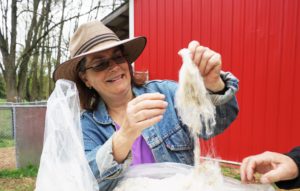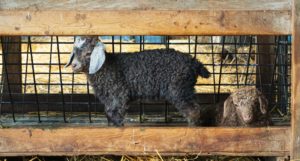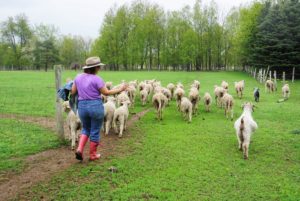
Bridget Kavanagh is the owner and shepherdess of Happy Goat Lucky Ewe Fiber Farm in Mason, Michigan.
By: Savannah Halleaux, Michigan FSA Public Affairs & Outreach Coordinator
“It was always my desire to have a sheep farm,” said Bridget Kavanagh, owner and shepherdess of Happy Goat Lucky Ewe Fiber Farm in Mason, Michigan.
Kavanagh bought the property in 1987 when her children were little. It wasn’t until her children grew up and started moving out on their own that Kavanagh was able to turn the homestead into a business.
“I didn’t go through the empty nest syndrome because I kept buying sheep,” Kavanagh joked.
Kavanagh saw the need to expand her sheep and goat herd to meet customer demand for her merino and angora goat fiber. Much of her prospective pasture land was covered in dense scrub brush, so Kavanagh first had to turn “the jungle” of thorny, overgrown brush into quality pasture for livestock.
“You had to have a machete to get through it,” she recalled.
Kavanagh visited her local USDA Service Center and learned her farm was eligible for the Environmental Quality Incentives Program (EQIP) through the Natural Resources Conservation Service (NRCS). EQIP provides agricultural producers with financial resources, along with one-on-one help to plan and implement conservation practices.
“The NRCS and county conservationists were willing to go out and traipse through the field,” Kavanagh said. “They had survey and satellite imagery and access to all the soil information for the property. They drew up a conservation plan and did all of the estimates on costs.”

Kavanagh saw the need to expand her sheep and goat herd to meet customer demand for her merino and angora goat fiber.
Kavanagh’s plan included brush clearing, grazing management, pollinator habitat and seasonal high tunnels over the course of several years. The conservation practices will not only allow her to graze more goats, but will also reduce soil erosion, improve soil health and protect water quality.
EQIP is a cost-share program that reimburses producers and landowners for a portion of the cost of implementing certain conservation practices. Still, Kavanagh had to cover the up-front costs before the reimbursement from NRCS was issued.
That’s when Kavanagh reached out to another USDA agency, the Farm Service Agency (FSA), to see if she was eligible for a microloan. FSA microloans offer more flexible access to credit for small, beginning and niche agricultural operations.
When Kavanagh first approached her local FSA farm loan manager, Dave Hemker, she didn’t know what to expect when it came to application requirements and her farm’s eligibility.
“They helped me figure out collateral and not obligate the farm. By the end, I was confident my farm had the ability to support the loan,” said Kavanagh. “Dave was amazing, and the microloan was the perfect amount.”
Kavanagh was able to use the FSA microloan to initially fund the fencing and brush clearing in her grazing management plan. The cost share from EQIP was then applied directly to the microloan debt, significantly reducing the loan principal.

Kavanagh was able to use an FSA microloan to initially fund the fencing and brush clearing in her grazing management plan through the NRCS Environmental Quality Incentives Program (EQIP).
“I really appreciate what USDA did for us. It is a jump start,” said Kavanagh.
In the coming years, Kavanagh will continue with EQIP by building a seasonal high tunnel to extend the growing season for cut flowers and dye-producing crops, install water lines to further implement her grazing management plan and create a pollinator habitat.
“In the end I’m just the steward of this property. We are only here on this Earth temporarily and it’s important to leave the land better than you found it for the next generation,” Kavanagh said. “Maybe our family will still be farming here in 100 years. It sure would be nice.”
More Information
USDA offers a variety of risk management, disaster, loan and conservation programs to help America’s agricultural producers weather ups and downs in the market and natural disasters as well as invest in improvements to their operations.
For more information about USDA programs, contact your local USDA service center or visit Farmers.gov.






3 Responses to Fiber Farm Weaves USDA Programs Together